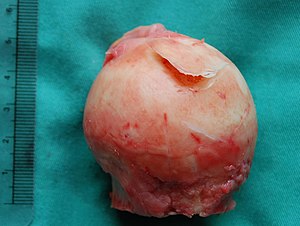Avascular necrosis
| Avascular necrosis | |
|---|---|
 |
|
| Femur head showing a flap of cartilage (osteochondritis dissecans) due to avascular necrosis. Specimen from total hip replacement surgery. | |
| Classification and external resources | |
| Specialty | Orthopedics |
| ICD-10 | M87 |
| ICD-9-CM | 733.4 |
| DiseasesDB | 1174 |
| MedlinePlus | 007260 |
| eMedicine | med/2924 |
| MeSH | D010020 |
Avascular necrosis (AVN), also called osteonecrosis, bone infarction,aseptic necrosis, and ischemic bone necrosis, is cellular death (necrosis) of bone components due to interruption of the blood supply. Without blood, the bone tissue dies and the bone collapses. If avascular necrosis involves the bones of a joint, it often leads to destruction of the joint articular surfaces. (see Osteochondritis dissecans).
While it can affect any bone, about half of cases show multiple sites of damage, avascular necrosis primarily affects the joints at the shoulder, knee, and hip. The classical sites are: head of femur, neck of talus and waist of scaphoid. In many cases there is pain and discomfort in joints which does not go away but rather increases over time.
Clinical avascular necrosis most commonly affects the ends (epiphysis) of long bones such as the femur (the bone extending from the knee joint to the hip joint). Other common sites include the humerus (the bone of the upper arm), knees, shoulders, ankles and the jaw. The disease may affect just one bone, more than one bone at the same time, or more than one bone at different times.
There are many theories about what causes avascular necrosis. Proposed risk factors include, chemotherapy, alcoholism, excessive steroid use, post trauma,caisson disease (decompression sickness), vascular compression,hypertension, vasculitis, arterial embolism and thrombosis, damage from radiation, bisphosphonates (particularly the mandible),sickle cell anaemia, and Gaucher's Disease. In some cases it is idiopathic (no cause is found).Lupus is also a common cause of AVN. Prolonged, repeated exposure to high pressures (as experienced by commercial and military divers) has been linked to AVN, though the relationship is not well-understood.
...
Wikipedia
